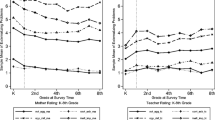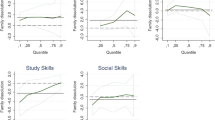Abstract
Preschool boys identified by their teachers as active, inattentive, and impulsive (N=42) were compared with matched classroom controls (N=43) and with parentidentified problem boys (N=27) on measures of family functioning often associated with children's problem behaviors, including family history of psychopalhology, stressful life events, and family composition. Teacher-identified and parent-identified problem boys did not differ on measures of family adversity, and both groups came from less well functioning families than comparison boys. Mothers of problem boys, regardless of referral source, were more negative and controlling toward their sons when observed in a compliance task. Children's problem behaviors were moderately stable over a oneyear follow-up period; initial symptom levels, maternal self-reported depression, and negative maternal control predicted follow-up ratings of externalizing problems.
Similar content being viewed by others
References
Achenbach, T. M., & Edelbrock, C. (1978). The classification of child psychopathology: A review and analysis of empirical efforts.Psychological Bulletin, 85, 1275–1301.
Achenbach, T. M., & Edelbrock, C. (1983).Manual for the Behavior Problem Checklist and Revised Child Behavior Profile. Burlington VT: Department of Psychiatry, University of Vermont.
American Psychiatric Association (1980).Diagnostic and statistical manual of mental disorders. Washington, DC: Author.
Barkley, R. A., Karlsson, J., & Pollard, S. (1985). Effects of age on the mother-child interactions of ADD-H and normal boys.Journal of Abnormal Child Psychology, 12, 631–637.
Bates, J. E., & Bayles, K. (1988). Attachment and the development of behavior problems. In J. Belsky & T. Nezworski (Eds.),Clinical implications of attachment. Hillsdale, NJ: Erlbaum.
Bates, J. E., Maslin, C., & Frankel, K. (1985). Attachment security, mother-child interaction, and temperament as predictors of behavior problem ratings at age three years. In I. Bretherton & E. Waters (Eds.), Growing points of attachment theory and research.Monographs of the Society for Research in Child Development, 50, 167–193.
Behar, L. (1977). The Preschool Behavior Questionnaire.Journal of Abnormal Child Psychology, 5, 265–276.
Belsky, J. (1984). The determinants of parenting: A process model.Child Development, 55, 83–96.
Campbell, S. B. (1989). Socialization and social development of hyperactive children. In M. Lewis & S. Miller (Eds.),Handbook of developmental psychopathology. New York: Pergamon Press.
Campbell, S. B. (1990a). Longitudinal studies of active and aggressive preschoolers: Individual differences in early behavior and in outcome. In D. Cicchetti & S. Toth (Eds.),Rochchester symposium on developmental psychopathology, Vol. 2. Hillsdale, NJ: Lawrence Erlbaum Associates.
Campbell, S. B. (1990b).Behavior problems in preschool children: Clinical and developmental issues. New York: Guilford Press.
Campbell, S. B., Breaux, A. M., Ewing, L. J., & Szumowski, E. K. (1984). A one-year follow-up of parent-identified behavior problem toddlers.Journal of the American Academy of Child Psychiatry, 23, 243–249.
Campbell, S. B., & Cluss, P. (1982). Peer relations of young children with behavior problems. In K. H. Rubin, & H. S. Ross (Eds.),Peer relationships and social skills in childhood. New York: Springer-Verlag.
Campbell, S. B., & Ewing, L. J. (1990). Hard-to-manage preschoolers: Adjustment at age nine and predictors of continuing symptoms.Journal of Child Psychology and Psychiatry, 31, 871–889.
Campbell, S. B., Ewing, L. J., Breaux, A. M., and Szumowski, E. K. (1986). Parent-identified behavior problem toddlers: Follow-up at school entry.Journal of Child Psychology and Psychiatry, 27, 473–488.
Campbell, S. B., Szumowski, E. K., Ewing, L. J., Gluck, D. S., & Breaux, A. M. (1982). A multidimensional assessment of parent-identified behavior problem toddlers.Journal of Abnormal Child Psychology, 10, 569–592.
Conger, R. D., McCarty, J. A., Yang, R. D., Lahey, B. B., & Kropp, J. P. (1984). Perception of child-rearing values, and emotional distress as mediating links between environmental Stressors and observed maternal behavior.Child Development, 55, 2234–2247.
Crowther, J. K., Bond, L. A., & Rolf, J. E. (1981). The incidence, prevalence and severity of behavior disorders among preschool-aged children in day care.Journal of Abnormal Child Psychology, 9, 23–42.
Fergusson, D. M., Horwood, L. J., & Shannon, F. T. (1984). Relationship of family life events, maternal depression, and child-rearing problems.Pediatrics, 73, 773–776.
Fischer, M., Rolf, J. E., Hasazi, J. E., & Cummings, L. (1984). Follow-up of a preschool epidemiological sample: Cross-age continuities and predictions of later adjustment with internalizing and externalizing dimensions of behavior.Child Development, 55, 137–150.
Lee, C. L. and Bates, J. E. (1985). Mother-child interaction at age two years and perceived difficult temperament.Child Development, 56, 1314–1323.
Lewis, M. Feiring, C., McGuffog, C &, Jaskir, J. (1984). Predicting psychopathology in sixyear-olds from early social relations.Child Development, 55, 123–136.
McGee, R., Silva, P. A., & Williams, S. (1984). Perinatal, neurological, environmental, and developmental characteristics of seven-year-old children with stable behavior problems.Journal of Child Psychology and Psychiatry, 25, 573–586.
Moffitt, T. (1990). Juvenile delinquency and attention deficit disorder: Boys' developmental trajectories from age 3 to 15.Child Development, 61, 893–910.
Panaccione, V. F., & Wahler, R. G. (1986). Child behavior, maternal depression, and social coercion as factors in the quality of child care.Journal of Abnormal Child Psychology, 14, 263–278.
Pelham, W., & Bender, M. E. (1982). Peer relationships in hyperactive children: Description and treatment. In K. Gadow and I. Bialer (Eds.),Advances in learning and behavioral disabilities (Vol. 1). Greenwich, CT: JAI Press.
Radloff, L. (1977). The CES-D Scale: A self-report depression scale for research in the general population.Journal of Applied Psychological Measurement, 1, 385–401.
Richman, N., Stevenson, J., & Graham, P. J. (1982).Preschool to school: A behavioral study. London: Academic Press.
Sameroff, A. J., & Chandler, M. (1975). Reproductive risk and the continuum of caretaking casualty. In F. D. Horowitz (Ed.),Review of child development research Vol. 4. Chicago: University of Chicago Press.
Sarason, I. G., Johnson, J. A., and Siegel, J. M. (1978). Assessing the impact of life changes: Development of the Life Experiences Survey.Journal of Consulting and Clinical Psychology, 46, 932–946.
Spanier, G. B. (1976). Measuring dyadic adjustment: New scales for assessing the quality of marriage and similar dyads.Journal of Marriage and the Family, 38, 15–28.
Sroufe, L. A., & Rutter, M. (1984). The domain of developmental psychopathology.Child Development, 55, 17–29.
Werner, E. E., & Smith, R. S. (1982).Vulnerable, but invincible: A longitudinal study of resilient children and youth. New York: McGraw-Hill.
Winer, B. J. (1971).Statistical principles in experimental design (2nd ed.). New York: McGrawHill.
Author information
Authors and Affiliations
Rights and permissions
About this article
Cite this article
Campbell, S.B., March, C.L., Pierce, E.W. et al. Hard-to-manage preschool boys: Family context and the stability of externalizing behavior. J Abnorm Child Psychol 19, 301–318 (1991). https://doi.org/10.1007/BF00911233
Revised:
Issue Date:
DOI: https://doi.org/10.1007/BF00911233




